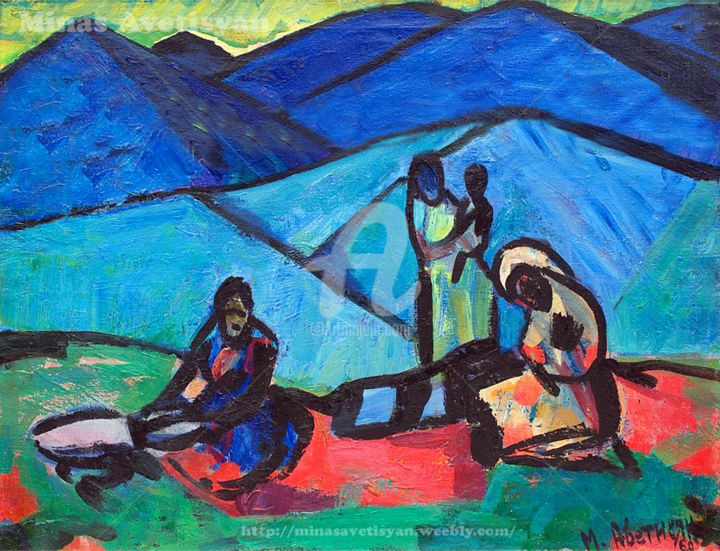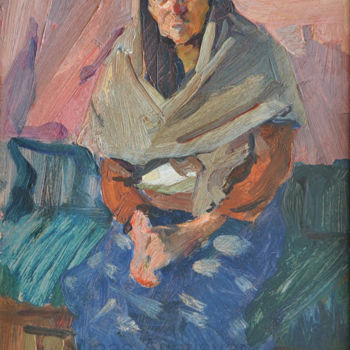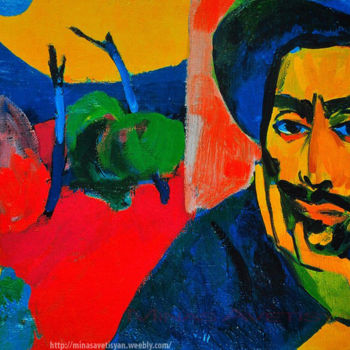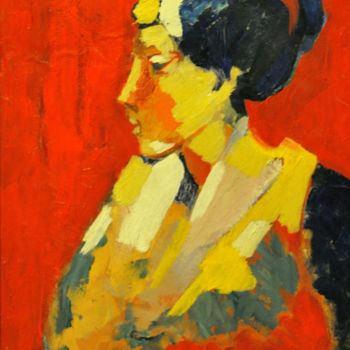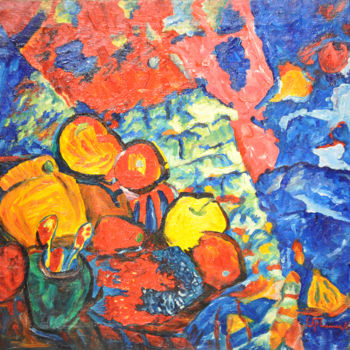Minas Avetisyan- in the mountains (1960) Painting by Minas Avetisian
Not For Sale
Sold by Minas Avetisian
This image is available for download with a licence
Sold by Minas Avetisian
-
Original Artwork
Painting,
Oil
on Canvas
- Dimensions Dimensions are available on request
- Categories Abstract
Mount Aragats
Mount Aragats Mount Aragats Mount Aragats Mount Aragats
“Is it really in Armenia?” “Wow, it’s a beast!” These are only two of the exclamations you might hear or people usually make at seeing this mountain, which is breathtaking and is always in the center of attention of those people including young and old who love mountains, who love camping and who love climbing high peaks.
Mount Aragats: General
Formed by a volcano eruption in the distant past Mount Aragats is the highest peak in Armenia. It has four peaks the highest of which is the Northern with 4090 meters of height. Then come the Western peak (4080 meters), the Eastern (3916 meters) and the Southern (3879 meters).
Traces of ancient culture as well as an ancient irrigation system were discovered on the slopes of the mountain. Also, fish-like monuments known as “dragons” and symbolizing cult of water were found. The slopes of the mountain are also known for some of the remarkable structures of medieval Armenian architecture that have been retained throughout the centuries, among them are the Fortress of Amberd, Byurakan observatory and Tegher Monastery.
Three mountains can be found in the neighborhood of Mount Aragats; Mt. Shara (to the north), Mt. Ara (to the east) and the mountains of Great Arten (to the south-east).
Mount Aragats: Etymology
The naming of the mountain is related to legendary Armenian hero Ara Geghetsik (Ara the Handsome). The roots of the naming are believed to be “Ara” (the name of the hero) and gah (meaning throne). Eventually, Aragats means the “Throne of Ara.”
Mount Aragats: Climate
The climate varies depending on the height; the higher you climb the colder the weather will be. In general, during summer-time the weather is moderately warm on the slopes, and cold in winters, while at peaks it might be really cold even during the summers. Note that the winters last long and are snowy with a steady snowpack of 250 days.
The landscapes also vary based on the height.
Mount Aragats: Springs
Hundreds of cool springs originate from the slopes of the mountain, which form the rivers of Kasagh, Gegharot, Amberd, Mantash, Geghadzor, Tsaghkahovit and so on. The springs coming out of the mountain’s slopes nourish the Lake of Metsamor located in Ararat plain.
Mount Aragats: Flowers, Animals
The massif of Mount Aragats is rich in alpine meadows around which fragrant flowers are all scattered. Among them are violets, wild lilies, poppies and bell-flowers.
According to historians, Aragats used to be covered with exuberant forests where wild animals lived. At the height of 1800-2300 meters there is still a small forest. The main tree growing there is the Eastern oak.
The following animals can be seen: long-eared jerboas, hares, foxes, wolves, turtles, snakes and lizards.
Mount Aragats: Summits
As already said, the mountain has four summits. If you are planning to have a round trip, the consider spending as long as 12-13 hours on the mountain. The lowest and nearest summit is the Southern, which can be reached within two hours from the lake. If you wish to reach the Western summit, then from the Southern it will take additional 1-2 hours to get there. The Northern summit will take 4 hours form the lake.
Note that the Southern summit is not only the nearest and the lowest but also the easiest. In a broader sense, every person can conquer it. The hardest one is the Northern, and a guide would be only to your own benefit. If you are planning to climb the mountain, then the most appropriate hour to start at is 6 or 7 am. Depending on how “deep” you would like to move, you might even have to wake up at 5 am.
Mount Aragats: Lake Kar
Lake Kar (Stone Lake in English and Kari Lich in Armenian) is a small lake on the slopes of Mount Aragats. It is located 3,190 meters above sea level. There is an automobile road taking to the alke from Byurakan village.
A taxi from capital Yerevan to Lake Kar will cost 15,000 Dram (around $37) at most.
Mount Aragats: Legends
There are various legends regarding this mountain but perhaps three of them are more worth being known.
Legend 1 – One day when Saint Grigor Lusavorich (Gregory the Illuminator) was praying on the top of Mount Aragats an ever burning lantern hanging from the sky illuminated him. People considered that lantern the symbol of hope and dreams and called it the “Lantern of Lusavorich.” It is said that the lantern is still there but is seen only to the chosen ones.
In case you don’t know, Grigor Lusavorich is the patron saint and the first official head of the Armenian Apostolic Church. Various churches dedicated to him can be found in Armenia. In capital Yerevan the most noteworthy one is the Church of Saint Grigor Lusavorich.
Legend 2 – A legend has it that once the Armenian mountains were huge and burly brothers that used to wake up early in the morning and before greeting each other wear their belts. This is how they lived for long years. But they got old and began to wake up late than usual. And one day after waking up they simply forgot to wear their belts and greeted each other without that having performed that “ritual.” It caused the rage of God, who punished them by turning the brothers into mountains, their belts into green fields and their tears into eternal springs. One of those mountains is Aragats, which is the fourth highest mountain in the Armenian Highland and which follows the mounts of Ararat, Sebelan and Sipan.
Legend 3 – Once Mount Aragats and Mount Masis (the same Mount Ararat) were two loving sisters. But one day they start arguing on which one is better, higher and more beautiful. Mount Maruta comes to help reconcile the two sisters but seeing how useless his efforts are he leaves and lays a curse upon both of them. The curse was as follows, “Let Mount Masis and Mount Aragats separate from each other so that they never meet again.” In her turn, Mount Masis cursed Aragats saying she wished the latter’s grief never relieved and the tears never dried. This was followed by Aragats’s curse, which wished that the mountain dried out from grief, nobody climbed it and no matagh (lamb/rooster sacrifice to God) were performed on it. The curses were fulfilled. The tears of Mount Aragats caused a lake to be formed on the mountain and various springs to originate from it. As to Masis, she became deserted, nobody climbs it and no matagh is performed there.
Related themes
MinasavetisyanMinasavetisianМинасаветисянMinasavedisianՄինասավետիսյան
Avetisian Minas Karapetovich is an Armenian painter, graphic artist, theatrical artist, an Armenian Honoured artist born in July 20, 1928 in the village of Jajur, Armenia.
Minas studied at Terlemezyan College of Fine Arts in Yerevan (1947–1952), Yerevan Fine Arts and Theater Institute (1952–1954), Painting, Sculpture and Architecture Institution Ilya Repin by name in Leningrad (1955–1959), where his main teacher was Boris Ioganson. From 1960 on Minas lived in Yerevan.
His first arts gallery took place in 1960, however, he got to be famous and known in 1962 after “Exhibition of Five” held in Yerevan. Numerous specialists and visitors to the exhibition appreciated greatly the well-established artist of bright individuality and his works.
Avetisian’s works characterized by seemingly wild brush work and strident colors gave new life to fauvism principles. You may as well easily trace some South Caucasus Middle Eve Arts traditions in his works. His works having a peculiar color saturation juxtaposed with an epic drama of bold shapes, nature paintings, self-portraits, symbolic countryside motives were interpreted at official exhibitions as a breakthrough to the freedom of esthetical self-expression. By this Avetisian got closer to the contemporary Russian rough style, even though in general he longed more to the French modern and early avant-garde style of early 20th.
Minas was also a success as a theatrical artist (theatre set design of Khachaturian's Gayane ballet at Opera and Ballet Theatre by Spendiarov Name, 1974) and as a monumental painter (factory interior wall-paintings in Leninakan- Gyumri, 1970-1974).
Minas travelled a lot around Armenia, searching for historical monuments, studying Armenian miniature works and works of the greatest Armenian artists, of Martiros Saryan in the first place. Saryan was Minas’s spiritual father. The young artist was a genuine successor of the great artist’s work and a symbol of a new development of national painting.
Following national traditions in painting, using means of expression found in ancient miniatures and considering the experience of famous artists, Minas, nevertheless, was never a blind copier. In his works he reflected the reality seen through his life perception and interpretation.
Unfortunately, many of his paintings were burned down in fire in 1972. In January 1 during the night time, while Avetisyan was in Jajur with his family, his studio in Yerevan was burned along with most of his best canvases.
Three years later, in 1975 Minas Avetisian died under the wheels of the car, which stopped off at the sidewalk. And the bad luck seemed to pursue him even after his death when part of his wall-paintings were destroyed during the earthquake in Leninakan (Gyumri) and razed to the ground Minas Avetisian’s museum in his native Jajur village.
In Armenia the name of Minas Avetisian is normally pronounced with affection. He committed his whole life (so tragically short) to Fine Arts. During 1960-1975 Minas managed to create over 500 canvases, big and small, and nearly the same amount of drawings, 20 big fresco’s and design projects for dozens of theatrical performances.
His works are introduced at Avetisian’s Home-Museum in Yerevan, Modern Arts Museum in Yerevan, Tretyakov Gallery in Moscow, Museum of Oriental Art in Moscow, as well as at numerous private collections in Armenia, Russia and other countries.
-
Nationality:
ARMENIA

- Date of birth : 1928
- Artistic domains:
- Groups: Contemporary Armenian Artists

